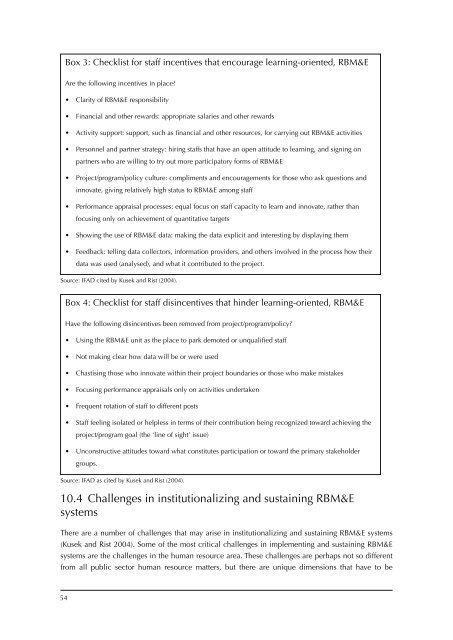A guide for practitioners
A guide for practitioners
A guide for practitioners
Create successful ePaper yourself
Turn your PDF publications into a flip-book with our unique Google optimized e-Paper software.
Box 3: Checklist <strong>for</strong> staff incentives that encourage learning-oriented, RBM&EAre the following incentives in place?• Clarity of RBM&E responsibility• Financial and other rewards: appropriate salaries and other rewards• Activity support: support, such as financial and other resources, <strong>for</strong> carrying out RBM&E activities• Personnel and partner strategy: hiring staffs that have an open attitude to learning, and signing onpartners who are willing to try out more participatory <strong>for</strong>ms of RBM&E• Project/program/policy culture: compliments and encouragements <strong>for</strong> those who ask questions andinnovate, giving relatively high status to RBM&E among staff• Per<strong>for</strong>mance appraisal processes: equal focus on staff capacity to learn and innovate, rather thanfocusing only on achievement of quantitative targets• Showing the use of RBM&E data: making the data explicit and interesting by displaying them• Feedback: telling data collectors, in<strong>for</strong>mation providers, and others involved in the process how theirdata was used (analysed), and what it contributed to the project.Source: IFAD cited by Kusek and Rist (2004).Box 4: Checklist <strong>for</strong> staff disincentives that hinder learning-oriented, RBM&EHave the following disincentives been removed from project/program/policy?• Using the RBM&E unit as the place to park demoted or unqualified staff• Not making clear how data will be or were used• Chastising those who innovate within their project boundaries or those who make mistakes• Focusing per<strong>for</strong>mance appraisals only on activities undertaken• Frequent rotation of staff to different posts• Staff feeling isolated or helpless in terms of their contribution being recognized toward achieving theproject/program goal (the ‘line of sight’ issue)• Unconstructive attitudes toward what constitutes participation or toward the primary stakeholdergroups.Source: IFAD as cited by Kusek and Rist (2004).10.4 Challenges in institutionalizing and sustaining RBM&EsystemsThere are a number of challenges that may arise in institutionalizing and sustaining RBM&E systems(Kusek and Rist 2004). Some of the most critical challenges in implementing and sustaining RBM&Esystems are the challenges in the human resource area. These challenges are perhaps not so differentfrom all public sector human resource matters, but there are unique dimensions that have to be54

















